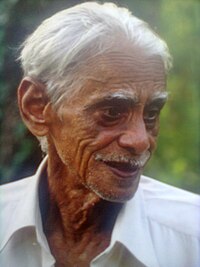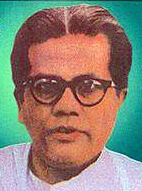Hiren Bhattacharyya, popularly known as Hiru Da among Assamese people, was one of the most celebrated poets in Assamese literature. Born in 1932 in the Jorhat district of Assam, he made an everlasting impact on Assamese poetry with his simple yet deeply emotional verses. His poetry reflected themes of love, life, and human emotions, making him a household name in Assam.
Early Life and Background
Hiren Bhattacharyya was born to Late Tirthanath Bhattacharyya, who worked as a jailer, and Late Snehalata Bhattacharyya. From an early age, he had a deep connection with literature and poetry. He started writing poems in his youth, and his first poem was published in 1957. Over the years, his works gained widespread recognition, and he became an essential figure in the Assamese Literary world.
The Journey of a Literary Icon
Hiru Da’s poetry is known for its simplicity, emotional depth, and strong connection with the common people. His words touched hearts, and his poetry became an integral part of Assamese Culture. Due to his unparalleled contribution to Assamese literature, he was also known as “Prem aru Rodalir Kobi,” which translates to “Poet of Love and Sunshine.”
He served as an editor for several prominent Assamese magazines and newspapers, including Chitrabon, Monon, and Antorik. These platforms played a crucial role in shaping Assamese literature, and his editorial skills helped bring many emerging writers into the spotlight.
Literary Contributions
Hiren Bhattacharyya’s works are a reflection of his deep understanding of human emotions and society. His poems often revolved around themes of love, patriotism, nature, and the struggles of everyday life. His ability to convey complex emotions in the simplest words made him unique.
Notable Poetry Collections:
- Mor Desh Mor Premor Kabita (1972)
- Bibhinna Dinar Kabita (1974)
- Kabitar Rode (1976)
- Tomar Gaan (1976)
- Sugandhi Pokhila (1981) (Selected Poems)
- Saichar Pathar Manuh (1991) (Collected Poems)
His poetry collections remain some of the most cherished books in Assamese literature. They continue to inspire poetry lovers, students, and scholars alike.
Nursery Rhymes and Children’s Literature
Apart from poetry, Hiren Bhattacharyya also wrote nursery rhymes, adding a special charm to Assamese children’s literature. His collections Lora Dhemali (1991) and Akon Dhemali (1991) are considered classics and are still enjoyed by children today. His work in this genre showed his versatility as a writer and his deep love for the Assamese language and culture.
Awards and Recognition
Hiru Da’s immense contributions to literature did not go unnoticed. He received numerous prestigious awards for his work. Some of the most notable ones include:
- Bishnu Rabha Award (1985) – For his outstanding contribution to Assamese literature.
- Soviet Desh Nehru Award (1987) – A mark of international recognition.
- Sahitya Akademi Award (1992) – One of the highest literary honors in India.
- Assam Valley Literary Award (2000) – A recognition of his lifetime achievements in Assamese literature.
These awards are a testament to his literary genius and his invaluable role in shaping Assamese literature.
Hiren Bhattacharyya’s Unique Writing Style
What made Hiru Da’s poetry stand out was its simplicity and directness. His verses were easy to understand, yet they carried deep emotions. He believed that poetry should be accessible to everyone, not just intellectuals or scholars. His words resonated with ordinary people, making his poetry a reflection of their own experiences.
Unlike many poets who write with complex metaphors and abstract ideas, Hiren Bhattacharyya used everyday language to express profound thoughts. His poems often spoke about love, longing, nature, and human relationships in a way that felt personal to every reader.
The Influence of Walt Whitman
Hiru Da considered all his poems to be part of one continuous work, much like the famous American poet Walt Whitman. This unique perspective made his poetry feel like an ongoing conversation with his readers, a never-ending journey of emotions and expressions.
His Final Years and Legacy
Hiren Bhattacharyya left an indelible mark on Assamese literature. Unfortunately, he passed away on July 4, 2012, due to lung and urinary infections. He left behind his wife and daughter, but more importantly, he left behind a treasure trove of poetry that continues to inspire generations.
Even after his passing, his influence remains strong. His poetry is still taught in schools, recited in cultural programs, and cherished by literature lovers. His legacy is one that will forever be celebrated in Assam and beyond.
Conclusion
Hiren Bhattacharyya was more than just a poet; he was a voice of the people. His works continue to touch hearts, inspire minds, and preserve the beauty of the Assamese language. Whether it’s his soulful poetry, his nursery rhymes, or his editorial contributions, his legacy will live on forever. For anyone who loves poetry, Hiru Da’s words are a timeless gift that keeps on giving.
FAQ’s
Q 1. Who was Hiren Bhattacharyya?
Hiren Bhattacharyya was a famous Assamese poet, known for his deep and emotional poetry. He was often called “Hiru Da” by his admirers and made a significant impact on Assamese literature with his simple yet powerful writing style.
Q 2. Why is Hiren Bhattacharyya called the “Poet of Love and Sunshine”?
He was called the “Poet of Love and Sunshine” because his poems beautifully captured emotions like love, warmth, and the essence of human life. His words brought hope and positivity, making him one of the most beloved poets in Assam.
Q 3. What are some of the famous works of Hiren Bhattacharyya?
Some of his most well-known poetry collections include Mor Desh Mor Premor Kabita, Sugandhi Pokhila, Kabitar Rode, and Saichar Pathar Manuh. He also wrote nursery rhymes for children, such as Lora Dhemali and Akon Dhemali.
Q 4. When did Hiren Bhattacharyya start writing poetry?
He began writing poetry at a young age, and his first published poem appeared in 1957. His first collection of poems, Mor Desh Mor Premor Kabita, was published in 1972, marking the beginning of his literary journey.
Q 5. Did Hiren Bhattacharyya receive any awards for his work?
Yes, he was honored with several prestigious awards, including the Bishnu Rabha Award (1985), the Soviet Desh Nehru Award (1987), the Sahitya Akademi Award (1992), and the Assam Valley Literary Award (2000) for his contribution to Assamese literature.
Q 6. What makes Hiren Bhattacharyya’s poetry unique?
His poetry stands out because of its simplicity and deep emotional connection with readers. He wrote about everyday life, love, and human emotions in a way that was easy to understand yet deeply meaningful.
Q 7. Apart from poetry, what other contributions did Hiren Bhattacharyya make?
He was also an editor for various Assamese magazines and newspapers like Chitrabon, Monon, and Antorik. His contribution to Assamese children’s literature through his nursery rhymes was also significant.
Q 8. What were some themes commonly found in Hiren Bhattacharyya’s poems?
His poetry often revolved around love, nature, patriotism, and human emotions. He had a special ability to express deep feelings in simple words, making his poems relatable to people of all ages.
Q 9. When and how did Hiren Bhattacharyya pass away?
He passed away on July 4, 2012, due to health complications related to lung and urinary infections. His death was a great loss to Assamese literature, but his legacy continues to inspire poetry lovers.
Q 10. How is Hiren Bhattacharyya remembered today?
He is remembered as one of the greatest poets of Assam, and his poems continue to be cherished. His works are still taught in schools and celebrated in literary circles, keeping his legacy alive for future generations.












